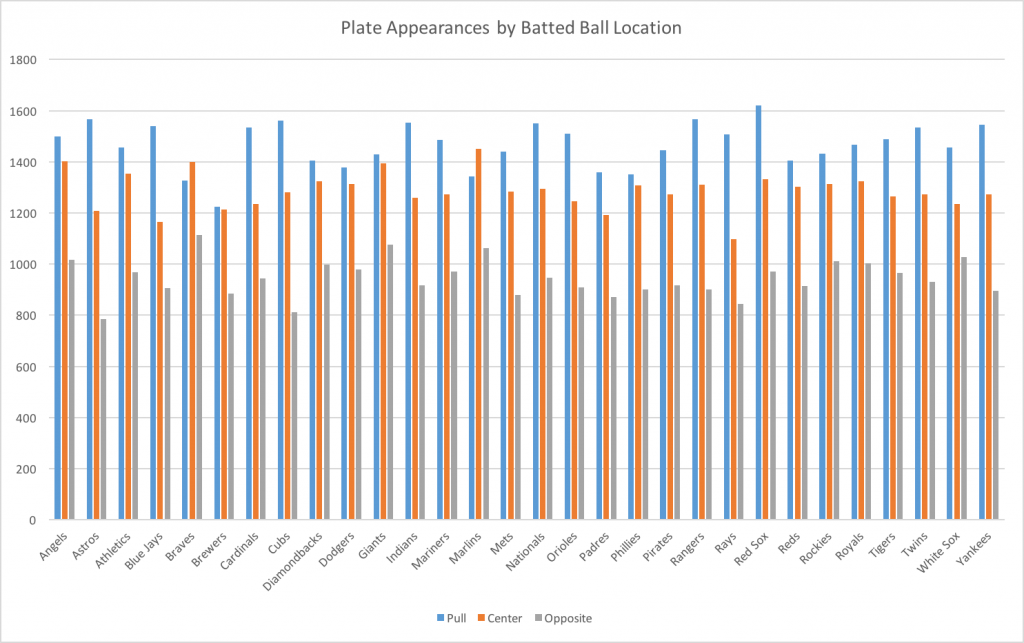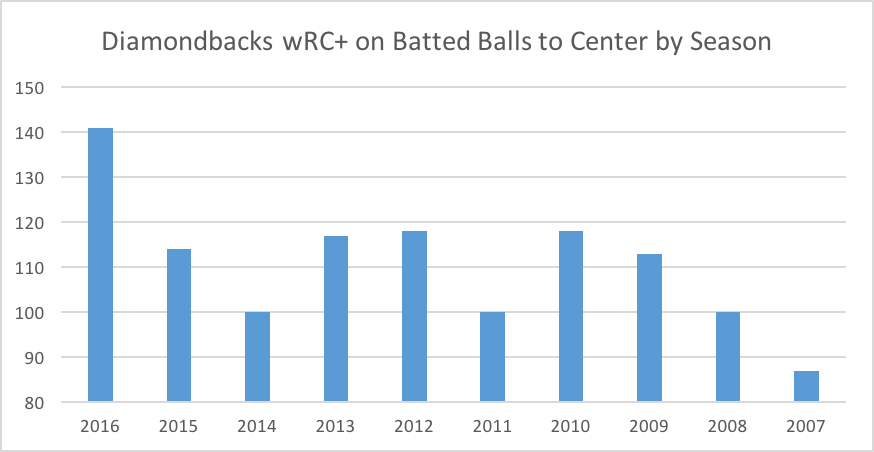Are Hits Up the Middle Hurting the Diamondbacks?
The Diamondbacks have an okay offense if you look at it through the standard lens of runs scored. By that measurement, they’re 14th in baseball. But, consider they’ve played 68 games at Chase Field and 10 more at Coors Field. Those are run-producing parks, as we’ve said a thousand times by now, and if you want to take park factors into consideration, well, the D-backs’ offense looks less okay. By wRC+, they stand 21st in the game and 8% below league average. They’ve lost many key cogs for large chunks of the season and the replacements have been basically very bad, so there you have it. It’s not really all that hard to figure out, I guess.
But within all that, there are plenty of little nuggets of information, one of which I stumbled upon recently. As it turns out, the Diamondbacks have had the most success of any team at going up the middle this season by both batting average and wRC+. That’s somewhat impressive considering batting average doesn’t account for park factors and wRC+ does. Paul Goldschmidt has a wRC+ of 200 on batted balls up the middle. Jean Segura has a 199 mark, Welington Castillo sits at 196. Keep in mind, that doesn’t account for walks or strikeouts, but you get the idea. They’ve been raking up the middle. Take a look at the batted ball profiles of all 30 MLB teams (click to enlarge):
Comparatively, the Diamondback look a little more balanced than most team. As it turns out, that’s exactly the case.
The team does go up the middle about as often as average. If we could get some decimals in these charts, you’d see that they do it about .75% more often than the average team, which isn’t a big difference. They’ve pulled the ball exactly 2% less frequently than average and gone to the opposite field 1.25% more often than average. While other teams are trying to pull the ball more frequently, the D-backs have been happy to trade in some of those pulled balls for more batted balls up the middle and the opposite way. With Chase Field being their playground, this makes sense and it’s something we’ve advocated for here many times. Spray the ball, let the big park go to work for you. With several other big parks in the division, this often works on the road, too.
It also comes with some consequences. With a more equal batted ball distribution, teams adjust accordingly. The Diamondbacks have been shifted on 6th least in the majors this season since there’s no major tendency to exploit. They also have a lack of left-handed bats at the moment and lefties tend to be shifted on more frequently than righties, so that’s part of the equation, too. But it should come as no surprise that the more a team tends to pull the ball, the more they get shifted. A simple correlation shows a relatively strong relationships between pulled balls in 2016 and shifts employed against in 2016 (.42, to be precise). That number would be higher if we filtered it just for situations with no men on base, but this tells a pretty compelling story regardless.
We also have to acknowledge that there’s a reason teams pull the ball so often. Even in this era of shifts, teams are employing players with an overwhelming tendency to pull the baseball. The reason for this is simple: pulled baseballs do more damage than any other batted ball location on average. And really, that’s all building a baseball team is, or at least should be — stacking the odds for productivity in your favor. So, should the Diamondbacks be pulling the ball more often? Let’s have a look at how the league has fared by batted ball location.
Starting with the league numbers, it’s staggering how much more productive pulled balls are than other types of batted balls. They’ve been 35% better than balls batted to center, even factoring in that pulled balls become hits less often. Opposite field hits do the least amount of damage, but become hits more often than pulled balls do. Batted balls up the middle become hits most often, but lack the kind of punch that pulled balls do. These things all feel very familiar.
For the D-backs, however, we see a monumental shift on balls hit up the middle. Pulled balls are still the most damaging, but hits up the middle have had a much stronger impact for Arizona than they have for the league as a whole. Some of that might be the ballpark, but some of it is also by design considering the players that have taken at-bats for the Diamondbacks this season. There are a number of players on the roster with strong up the middle approaches. They’re not often trying to pull the ball, instead opting to take balls back up the middle. They’ve done surprising well in the power department for balls hit the other way, and you can thank Yasmany Tomas for a good chunk of that.
Back to our question, though, should the D-backs be trying to pull the ball more often as a team? A definitive answer would require a much deeper dive into each hitters’ career tendencies and historical data for ballparks, but maybe it boils down to this: can we expect the team to continue doing as well as it has on batted balls to center? If there’s some kind of major advantage to hitting the ball to center in Chase Field, we’d expect to see a trend that could be exploited, but that’s not exactly the case.
The team’s damage done by wRC+ on balls hit up the middle is at an all-time high, and it’s frankly not even close. The team reached a wRC+ of 118 in 2010 and 2012, but that’s as close as they’ve come to the 141 mark they’re currently sitting on. This is clearly an outlier, one that might be due in part to roster make up, but is so far outside the norm that accounting for just the addition of Jean Segura, Michael Bourn and the reemergence of Chris Owings can’t explain it all. Weird things happen in baseball and that’s probably our best explanation. This is a strange occurrence to be sure and one that we’d do well not count on going forward.
And that brings us back to the idea that, yeah, they probably should be pulling the ball a little more. Not drastically more, but more nonetheless. The benefits outweigh the consequences, and while slapping the ball around in Chase Field can prove extra beneficial, hitting it with authority to the pull field should still be a priority. It’s not as if you’d go tell Jean Segura to quit spraying the ball all over the place, but perhaps hitters should be more aggressive in hitter’s counts. Just because the ball flies all over in Chase doesn’t mean that pulling the ball less useful in it’s own right, it just means that batted balls to other locations have a little extra juice, too.
Maybe getting David Peralta back will help. Maybe moving Yasmany Tomas could help. Maybe coaching the hitters to be up at the plate looking to do damage when the count’s in their favor can help. Right now, the D-backs are one of the most balanced clubs in the majors, and maybe that’s actually hurting them. We’ve been burned by the Jason Kubels and Mark Trumbos of the world in the past, so selling out for pulled balls probably isn’t the right idea, but a small move in that direction could pay dividends for the club’s offense. Because, let’s face it, they’re going to need all the help they can get in 2017.
Recent Posts
@ryanpmorrison
 Congrats to @OutfieldGrass24 on a beautiful life, wedding and wife. He deserves all of it (they both do). And I cou… https://t.co/JzJtQ7TgdJ, Jul 23
Congrats to @OutfieldGrass24 on a beautiful life, wedding and wife. He deserves all of it (they both do). And I cou… https://t.co/JzJtQ7TgdJ, Jul 23 Best part of Peralta’s 108 mph fliner over the fence, IMHO: that he got that much leverage despite scooping it out… https://t.co/ivBrl76adF, Apr 08
Best part of Peralta’s 108 mph fliner over the fence, IMHO: that he got that much leverage despite scooping it out… https://t.co/ivBrl76adF, Apr 08 RT @OutfieldGrass24: If you're bored of watching Patrick Corbin get dudes out, you can check out my latest for @TheAthleticAZ. https://t.co/k1DymgY7zO, Apr 04
RT @OutfieldGrass24: If you're bored of watching Patrick Corbin get dudes out, you can check out my latest for @TheAthleticAZ. https://t.co/k1DymgY7zO, Apr 04 Of course, they may have overtaken the league lead for outs on the bases just now, also...
But in 2017, Arizona ha… https://t.co/38MBrr2D4b, Apr 04
Of course, they may have overtaken the league lead for outs on the bases just now, also...
But in 2017, Arizona ha… https://t.co/38MBrr2D4b, Apr 04 Prior to the games today, there had only been 5 steals of 3rd this season (and no CS) in the National League. The… https://t.co/gVVL84vPQ5, Apr 04
Prior to the games today, there had only been 5 steals of 3rd this season (and no CS) in the National League. The… https://t.co/gVVL84vPQ5, Apr 04
Powered by: Web Designers@outfieldgrass24
 RT @kileymcd: Source: D'Backs are calling up Daulton Varsho. Son of former MLBer Gary, Top 100 prospect, plus runner with plus co… https://t.co/QHPGqGB7cY, 46 mins ago
RT @kileymcd: Source: D'Backs are calling up Daulton Varsho. Son of former MLBer Gary, Top 100 prospect, plus runner with plus co… https://t.co/QHPGqGB7cY, 46 mins ago RT @Kazuto_Yamazaki: https://t.co/9jtcri4Kp0, 2 hours ago
RT @Kazuto_Yamazaki: https://t.co/9jtcri4Kp0, 2 hours ago Welcome to The VarShow https://t.co/tLlO8AAA7T, 55 mins ago
Welcome to The VarShow https://t.co/tLlO8AAA7T, 55 mins ago Nick Madrigal coming up makes it a great day to be a Beaver #GoBeavs, 3 hours ago
Nick Madrigal coming up makes it a great day to be a Beaver #GoBeavs, 3 hours ago
Powered by: Web Designers









